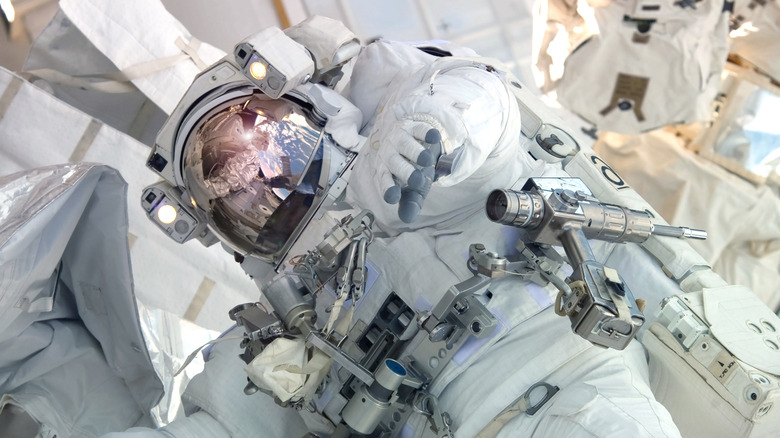This Is How Much A Full NASA Space Suit Costs
Perhaps one of NASA's most iconic innovations is its spacesuit. Featured in countless images and videos over the past several decades, these suits are designed to protect astronauts from the perils of space, making it possible to conduct spacewalks outside of the International Space Station and more. As you may imagine, these suits are incredibly complex and with that complexity comes an astronomical price tag.
With a new era of space exploration upon us, it's no surprise NASA is funding the development of a next-generation spacesuit, one that will, it anticipates, pack high-speed data communications capabilities, a high-definition camera with lights, and more. The space agency has spent years developing this next-generation suit, and it, too, has proven wildly expensive with hundreds of millions of dollars already spent, according to an audit report published by the agency's Office of Inspector General. Just how much does a single space suit cost NASA?
The answer is complicated
The NASA spacesuit we're all familiar with today is called an Extravehicular Mobility Unit (EMU), and it was designed more than four decades ago. Despite seemingly functioning as protective apparel for astronauts, the EMU is, in reality, a type of vehicle; it features multiple components integrated together to form a complete suit, including a Hard Upper Torso, Lower Torso Assembly, life support system, helmet, and more.
As noted by NASA's Office of Inspector General in a 2017 report, EMUs were only designed to last 15 years. The Space Shuttle Program for which these suits were originally made is long behind us, yet astronauts on the ISS continue to use "refurbished and partially redesigned" versions of them, the report says.
There's no single price tag for a spacesuit, as multiple versions have existed throughout the decades, and working out their exact individual costs is tricky. With that said, multiple sources and reports have given the public a rough idea of how much money goes into developing and producing a single suit. ILC Dover, the manufacturer behind the baseline and enhanced EMUs, noted a reported price of around $2 million per suit — though, it explained in a 1994 report preserved on NASA's history website, these aren't single-use suits, and the ability to reuse them is a factor to consider when working out their ultimate cost.
The University of Delaware, meanwhile, reports that an ILC Apollo-era spacesuit used to walk on the moon likely cost between $75,000 and $100,000 to make in the 1960s, which would put the present-day cost well beyond half a million dollars per unit. On top of that, ILC didn't make all of the parts for these suits, meaning the overall costs to NASA were likely substantially higher when factoring in other contractors and their contributions. Insider reports an estimated price of $15 million to $22 million per unit for the spacesuit made in 1974 — and that's not accounting for inflation in the decades since, which would push the price up to around $150 million today.
Next-generation spacesuits will be even more expensive
As mentioned, NASA is already working on the development of a next-generation spacesuit, which it refers to as the Exploration Extravehicular Mobility Unit (xEMU). These suits will be used by astronauts under the space agency's massive Artemis and Gateway efforts, among other future planned and anticipated missions. The Inspector General report revealed that between 2008 and 2021 when the audit was conducted, NASA had spent $420 million developing next-generation suit technology — and despite that, it looks like it won't manage to have a couple of suits ready for its highly ambitious goal of returning humans to the moon in 2024.
There's no exact figure for the cost of the xEMUs, but in its 2021 report, the NASA Inspector General determined the space agency likely won't have two xEMU suits ready for use until April 2025. By the time those two units are available, NASA will have likely spent more than $1 billion on the spacesuits, including the development and assembly costs, the audit found, putting each xEMU at a price tag of around $500 million.


